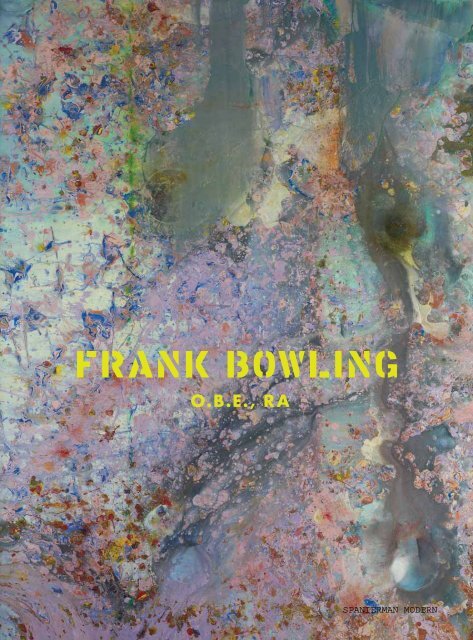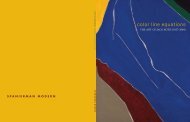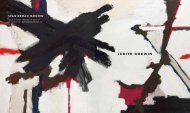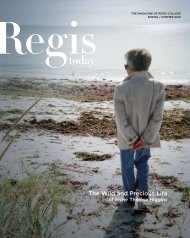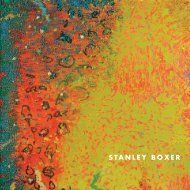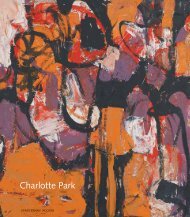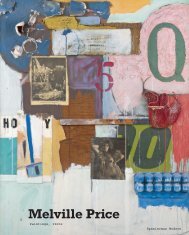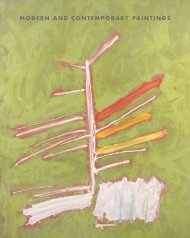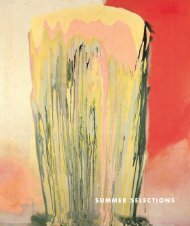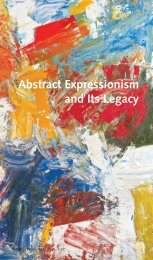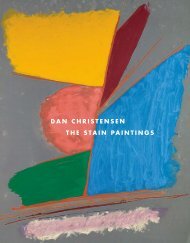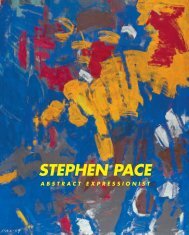View the catalogue - Spanierman Modern
View the catalogue - Spanierman Modern
View the catalogue - Spanierman Modern
You also want an ePaper? Increase the reach of your titles
YUMPU automatically turns print PDFs into web optimized ePapers that Google loves.
FRANK BOWLING<br />
O.B.E., RA
Published in <strong>the</strong> United States of America in 2010 by<br />
<strong>Spanierman</strong> <strong>Modern</strong>, 53 East 58th Street, New York, NY 10022<br />
Copyright © 2010 <strong>Spanierman</strong> <strong>Modern</strong>.<br />
All rights reserved. No part of this publication may<br />
be reproduced, stored in a retrieval system, or transmitted<br />
in any form or by any means, electronic, mechanical,<br />
photocopying, recording, or o<strong>the</strong>rwise, without prior<br />
permission of <strong>the</strong> publishers.<br />
isbn 978-1-935617-04-4<br />
Photography: Roz Akin<br />
Design: Amy Pyle, Light Blue Studio
FRANK<br />
BOWLING O.B.E., RA<br />
PAINTINGS 1974–2010<br />
ESSAY BY MEL GOODING<br />
SEPTEMBER 14 – OCTOBER 16, 2010<br />
SPANIERMAN MODERN<br />
53 EAST 58TH STREET NEW YORK, NY 10022- 1617 TEL (212) 832- 1400<br />
MCAMPBELL@SPANIERMAN.COM<br />
WWW.SPANIERMANMODERN.COM
2<br />
FIG. 1. SCOTT’S EYETOOTH 1982 MIXED MEDIA ON CANVAS 68 1 ⁄4 54 3 ⁄4 IN.
A POET IN NEW YORK: REFLECTIONS ON THE EXHIBITION<br />
For I is someone else. If brass wakes up as a bugle, it is no fault of its own.<br />
That is obvious to me: I am present at <strong>the</strong> hatching of my thought. —Rimbaud<br />
TITLE AND WORK<br />
What’s in a name? That which we call a rose<br />
By any o<strong>the</strong>r name would smell as sweet.<br />
—Shakespeare<br />
Iwill begin with a very recent, exemplary<br />
painting by Frank Bowling: Pondlife (2010). I<br />
am struck by <strong>the</strong> evocative title, at once seeming<br />
celebratory (of <strong>the</strong> natural) and ironic (being a<br />
term of mild abuse, a demotic misappropriation<br />
of something intrinsically interesting and beautiful).<br />
It is in fact an abstract painting created<br />
without premeditation of any such kind of<br />
evocation or reference, and its title is arbitrary,<br />
even whimsical: it might have been something<br />
quite o<strong>the</strong>r. (This in itself carries a hint of<br />
irony in <strong>the</strong> relation of work to spectator: you<br />
want a title? I will give you a title: how about<br />
Pondlife?) The title hints never<strong>the</strong>less—just—at<br />
description, and yet it is open to possibilities<br />
of poetic ambiguity, as is <strong>the</strong> picture itself.<br />
The one-word contraction is a poet’s device,<br />
suggesting that <strong>the</strong> watery space, which we are<br />
invited by <strong>the</strong> central panel to imagine, is in itself<br />
an enclosed world-entire, in a condition of interactive<br />
being, dynamic and fluid. This is a world<br />
in which <strong>the</strong> discrete lives of <strong>the</strong> plants and<br />
creatures that inhabit it—as spatter and speckle,<br />
paint-stain and combed flow of acrylic gel—<br />
are at one with <strong>the</strong>ir aquatic element, simultaneously<br />
separating and coalescing, in dynamic<br />
suspension between becoming and entropy.<br />
This is how poetic suggestion works, and I<br />
am reminded that Bowling as a young man set<br />
out to become a poet and to study literature:<br />
his titles have always given license to his love<br />
of word-play. Bowling is aware of <strong>the</strong> title as<br />
<strong>the</strong> subtle hinge that attaches a painting to<br />
<strong>the</strong> world beyond its edges and surfaces, <strong>the</strong><br />
world of imag inative response, reflective<br />
thought and natural language. The title is in<br />
this sense <strong>the</strong> first contact <strong>the</strong> painting makes<br />
with <strong>the</strong> wider critical and historical discourse.<br />
(Withholding a title—besides making life diffi -<br />
cult for historians—is itself a way of determining<br />
aspects of <strong>the</strong> first round of critical response.)<br />
While acknowledging that abstract painting<br />
might want to admit into its ambit of effect and<br />
affect <strong>the</strong> power of <strong>the</strong> poetic allusion, Bowling<br />
has never, in his paintings after 1972, extended<br />
this to any kind of mimetic figuration or signmaking,<br />
however ghostly or subliminal. In <strong>the</strong><br />
paintings prior to that date—a period that culminated<br />
in his one-person show of <strong>the</strong> abstract<br />
“map paintings” at <strong>the</strong> Whitney in 1971—it<br />
was just such use of <strong>the</strong> map-sign, as a vague<br />
emanation or a fading cipher, that had drawn<br />
critical and public attention to his paintings<br />
as carrying, like flags, some kind of political<br />
implication, and as having affinities with Pop.<br />
But Bowling has always made cunning and<br />
witty use of titles: he knows that a title may<br />
be intriguingly enigmatic or helpfully allusive;<br />
it may be anecdotal, celebrating or commemorating<br />
a person or an event, whe<strong>the</strong>r trivial or<br />
momentous; it may summon to mind a myth or<br />
legend; it may prompt a recollection of things<br />
past; it may refer to a natural phenomenon, a<br />
place or an effect of light. A title may also, of<br />
course, deflect immediate associations of a color,<br />
form or texture in order to free <strong>the</strong> observer’s<br />
mind to imaginative invention. In <strong>the</strong>se ways<br />
his titles are very like those we often encounter<br />
in modern jazz—ano<strong>the</strong>r abstract modernist<br />
art—a number of which Bowling has knowingly<br />
and pointedly appropriated or adapted.<br />
It might seem in pondering Pondlife (and its<br />
title) that I have hi<strong>the</strong>rto been concentrating<br />
solely on that band of richly worked canvas,<br />
its surface agitated, which is stitched and stuck<br />
on to <strong>the</strong> larger thinly painted canvas that<br />
supports it. But in fact it is easy to see how <strong>the</strong><br />
atmospheric parallels of translucent pink and<br />
green acrylic-wash might in <strong>the</strong>mselves be seen<br />
as an invitation to <strong>the</strong> ambiguities of <strong>the</strong> title:<br />
<strong>the</strong> impression <strong>the</strong>y give is of an untroubled<br />
watery surface catching <strong>the</strong> evening sun.<br />
The simultaneous sensations as of peering<br />
into depth (into <strong>the</strong> hectic self-contained<br />
world of <strong>the</strong> sewn strip) and of scanning an<br />
illuminated aqueous surface receding into <strong>the</strong><br />
distance remind me of Monet’s exploitation<br />
3
FIG. 2.<br />
PONDLIFE 2010<br />
ACRYLIC ON CANVAS<br />
57 51 IN.<br />
of <strong>the</strong> same simultaneity—a vertiginous sensory<br />
ambivalence—in Les Nymphéas, those great<br />
paintings of pond life. Such a recollection<br />
of <strong>the</strong> late work of Monet (which is not of<br />
immediate resemblance but of resemblances<br />
of effect) is not infrequent in contemplating<br />
Bowling’s painting, bringing with it always<br />
<strong>the</strong> implications of a critical conflict between<br />
an art of associative impressions (of objective<br />
natural phenomena, say, or of feelings of awe<br />
or wonder) and that of a purely abstract<br />
objectivity of <strong>the</strong> kind advocated by Clement<br />
Greenberg as truly “modernist” painting.<br />
PAINTINGS AND THEIR HISTORIES<br />
The poet makes himself a seer by a long and<br />
systematic derangement of all <strong>the</strong> senses.<br />
—Rimbaud<br />
That complexity of effect, in which our<br />
viewing of a painting veers between <strong>the</strong><br />
perception of naturalistic effects in <strong>the</strong> picture,<br />
and our apprehension of a surprising and<br />
beautiful object—<strong>the</strong> painting itself—in our<br />
immediate world, is one that Bowling achieves<br />
without fail, in different ways, in all his later<br />
paintings. The powerful contradiction of image<br />
and object is not entirely unlike <strong>the</strong> effect of<br />
early Jasper Johns, where <strong>the</strong> common sign<br />
disappears from mind, so to speak, in <strong>the</strong> face<br />
of a rich tactile complexity of facture, <strong>the</strong><br />
objective physicality of <strong>the</strong> work as a whole.<br />
As in <strong>the</strong> paintings here, it is a facture that<br />
suggests no effort at self-expression; ra<strong>the</strong>r, a<br />
kind of objectivity.<br />
In respect of this, <strong>the</strong>re is an aspect of Pondlife<br />
which serves to give it a particular historical<br />
poignancy. For <strong>the</strong> canvas on which is laid <strong>the</strong><br />
ground (for want here of a more accurate term)<br />
of pale purple, pink and green translucencies,<br />
an ambience of light created by lightly brushed<br />
thinned acrylic, is in fact recycled (in a process<br />
habitual to Bowling’s practice) from an earlier,<br />
abandoned painting, of 1972. That year Bowling<br />
came to know Greenberg, who began a kind<br />
of Socratic dialogue with <strong>the</strong> younger artist<br />
(Bowling was in his mid-thirties). The critic<br />
subtly opened up a critical-creative space<br />
within which Bowling found that he could<br />
move beyond an art of direct reference or<br />
overt symbolism (of <strong>the</strong> kind indicated by <strong>the</strong><br />
stenciled images of his mo<strong>the</strong>r’s house and<br />
hemispheric maps) to a formalist abstraction<br />
that freed him from any kind of quasi-political<br />
identity not of his own choosing.<br />
It may be said, in passing, that for Bowling at<br />
this time <strong>the</strong> espousal of a non-referential, nonsymbolic<br />
formalism was in fact a crucial moral<br />
and political act: “Formalist art. . . is almost<br />
always hard on itself and indulges in rigorous<br />
self-criticism, within <strong>the</strong> given discipline alone,”<br />
he wrote in May 1972. “[The] practice of<br />
painting within <strong>the</strong> boundaries of Formalism<br />
provides a setting in which I am able to test and<br />
ultimately prove my own freedom.” These words<br />
closely echo in spirit those of Greenberg in<br />
his classic 1961 essay, “<strong>Modern</strong>ist Painting” in<br />
which a purist (and puritan) definition of formalist<br />
abstraction is provided with great clarity.<br />
It quickly emerged that what <strong>the</strong> unique<br />
and proper area of competence of each art<br />
coincided with all that was unique to <strong>the</strong> nature<br />
of <strong>the</strong> medium. The task of self-criticism<br />
became to eliminate from <strong>the</strong> effects of each<br />
art any and every effect that might conceivably<br />
be borrowed from or by <strong>the</strong> medium of any<br />
o<strong>the</strong>r art. Thereby each art would be rendered<br />
“pure,” and in its “purity” find <strong>the</strong> guarantee<br />
of its standards of quality as well as of its<br />
independence. “Purity” meant self-definition,<br />
and <strong>the</strong> enterprise of self-criticism in <strong>the</strong> arts<br />
became one of self-definition with a vengeance.<br />
The juxtaposition in Pondlife of two distinct<br />
styles, one sampled, as it were, from an earlier<br />
music, has implications at once ironic and<br />
nostalgic. It is ironic, in that a beautiful and<br />
4
FIG. 3.<br />
BASKET 2010<br />
ACRYLIC ON CANVAS<br />
26 1 ⁄2 51 IN.<br />
moving object has been created with deliberative<br />
procedures, objective craft, and arbitrary, even<br />
automatic, decisions, but it is an object made<br />
without premeditation of its eventual appearance<br />
and effect. Bowling could not know that he<br />
would see possibilities of allusion suggested by<br />
a title given post facto.<br />
The incorporation of strips and fragments<br />
cropped from earlier work was to be an<br />
enduring creative ploy of Bowling’s. That<br />
Pondlife as a whole retrieves (as memory may<br />
be said to retrieve) material that belongs to<br />
<strong>the</strong> innocent and earnest purity of his earlier<br />
formalist intentions brings nostalgic resonance.<br />
It is a visible remembrance of his briefly held<br />
ambition, under <strong>the</strong> immediate influence<br />
of Greenberg, to succeed as a post-painterly<br />
color-field abstractionist. A handful of beautiful<br />
paintings survive from 1972–73 as proof of that<br />
success. But intention in Bowling’s procedures<br />
does not extend to <strong>the</strong> allusive or affective.<br />
He works close to <strong>the</strong> surface, close to <strong>the</strong><br />
materials of his art. After “<strong>the</strong> long and systematic<br />
dérèglement” of <strong>the</strong> working process, <strong>the</strong><br />
magician-seer steps back and—voila!—Pondlife!<br />
The primary purpose of <strong>the</strong> collage elements<br />
in Bowling’s paintings is to draw attention<br />
to <strong>the</strong>se deliberative procedures—at once<br />
experimental and constructive, automatic and<br />
determined—by means of which <strong>the</strong> work<br />
is created. The stitched and stapled matte<br />
chromatic strips and rectangles are juxtaposed<br />
directly with richly variegated painterly surfaces<br />
that glimmer and shine. The contrasts operate<br />
as a kind of alienation effect, drawing attention<br />
to form and facture. Frequently <strong>the</strong>se fabric<br />
retrievals provide a simple-seeming frame or<br />
border to a complex newly painted image. As<br />
a secondary effect this can intensify evocation:<br />
in Old Dutch Vase, Vines and Basket (all 2010),<br />
for examples, <strong>the</strong> titles may suggest that we are<br />
looking at still-life pictures in which floral<br />
color and petal-scatter are set against window<br />
light: a marvelous new kind of flower painting.<br />
In Amelia (2002) we look over a sill into a night<br />
sky. In Resting, Alighting, Hovering (all 2010), <strong>the</strong><br />
color stiles at ei<strong>the</strong>r side serve to stabilize quasicosmic<br />
images of subtle stasis or kinesis, <strong>the</strong>mselves<br />
cut from recent “zipper” paintings, such<br />
as <strong>the</strong> beautiful, e<strong>the</strong>real Fairmaid (2009).<br />
PROCEDURES TO MAKE PAINTINGS;<br />
PAINTINGS TO GENERATE IMAGES<br />
Nature is not mechanical. ... Its prodigy is not<br />
identity but resemblance and its universe of<br />
reproduction is not an assembly line but an<br />
incessant creation. Because this is so in nature, it<br />
is so in metaphor. Nor are we talking of imitation.<br />
—Wallace Stevens<br />
Immersed as he was in <strong>the</strong> painting culture<br />
of New York in <strong>the</strong> late 1960s and 1970s (as<br />
a critic-polemicist as well as a painter whose<br />
acquaintance extended beyond <strong>the</strong> milieu of<br />
abstract painting), Bowling was keenly aware<br />
of <strong>the</strong> <strong>the</strong>oretical discussion that animated<br />
<strong>the</strong> studios, apartments and bars inhabited or<br />
frequented by <strong>the</strong> painters of <strong>the</strong> time. He<br />
became increasingly aware of <strong>the</strong> ways in which<br />
5
<strong>the</strong>se technical aspects of a painting might add<br />
complexity to a work and its reception. He<br />
had always worked, and continued to do so<br />
<strong>the</strong>reafter, with an intense critical reflexivity, a<br />
consciousness of relations between different<br />
aspects of a work, and between <strong>the</strong> painting itself<br />
and o<strong>the</strong>r paintings, his own or those of o<strong>the</strong>r<br />
artists, past and present. This self-consciously<br />
critical aspect is always visible in Bowling’s<br />
paintings as a kind of meta-subject. It is part<br />
of <strong>the</strong> experience, part of <strong>the</strong> fun.<br />
“<strong>Modern</strong>ism,” as Greenberg had observed,<br />
characteristically “criticizes from <strong>the</strong> inside,<br />
through <strong>the</strong> procedures <strong>the</strong>mselves of that<br />
which is being criticised.” So it is not surprising<br />
that soon after his experiments with color-field<br />
Bowling looked for o<strong>the</strong>r ways, less indebted<br />
to Newman and Rothko, in which to create<br />
an imagery that not only eliminated personal<br />
touch and signature, but were less easily read<br />
as pictorial and atmospheric. Thin-wash acrylic<br />
fields, translucent, diaphanous, cannot but evoke<br />
pictorial space and induce mood. Bowling be -<br />
came increasingly concerned, however, to create<br />
brilliant objects ra<strong>the</strong>r than beautiful images.<br />
In a competitive environment, Bowling<br />
was working now with a keen awareness of<br />
<strong>the</strong> inexpressive post-painterly procedures of<br />
Morris Louis, Kenneth Noland, Larry Poons<br />
and Jules Olitski. Pouring, spraying, staining,<br />
masking, cropping, screening, applications of<br />
acrylic gel, un-stretched canvases, shaped supports;<br />
acrylic paint applied with openness of<br />
design and a self-declarative clarity of execution:<br />
<strong>the</strong>se were <strong>the</strong> technical and stylistic characteristics<br />
of much of <strong>the</strong> most critically successful<br />
New York abstract painting. Bowling’s own<br />
response to <strong>the</strong> challenge of “modernist”<br />
formalism, to forgo <strong>the</strong> “expressive touch,” to<br />
discover a new reality in painting-as-painting<br />
(in what <strong>the</strong> early Russian abstractionists he<br />
admired would have called “painting-as-such”)<br />
was extreme.<br />
The poured paintings of <strong>the</strong> mid-1970s<br />
were created by means of a mechanical device<br />
of Bowling’s own invention: a tilting boardplatform,<br />
whose angle of tilt could be controlled<br />
by pegs at each end, and which allowed <strong>the</strong><br />
paint to flow downwards over <strong>the</strong> stretched<br />
canvas at a determined speed, its velocities<br />
susceptible to adjustment. In effect <strong>the</strong> painting<br />
made itself with a minimum of assistance from<br />
<strong>the</strong> painter. In <strong>the</strong>ir thrilling unpredictability,<br />
and <strong>the</strong>ir vertiginous disposition of <strong>the</strong> pure<br />
materials of <strong>the</strong>ir art, <strong>the</strong>se poured paintings<br />
have about <strong>the</strong>m something very close to <strong>the</strong><br />
free-form excitement of contemporaneous<br />
advanced New York jazz, itself a brilliant<br />
manifestation of <strong>the</strong> <strong>Modern</strong>ist spirit. “The<br />
inventions of <strong>the</strong> unknown,” wrote Rimbaud,<br />
“demand new forms.”<br />
What gives <strong>the</strong>se objects <strong>the</strong>ir extraordinary<br />
power, <strong>the</strong>ir startling visual impact, is ano<strong>the</strong>r<br />
kind of unpredictability altoge<strong>the</strong>r. They are<br />
images of <strong>the</strong> natural processes which made<br />
<strong>the</strong>m what <strong>the</strong>y are. They cannot <strong>the</strong>refore avoid<br />
resemblance to o<strong>the</strong>r phenomena whose forms<br />
and effects are created by similar dynamics.<br />
The titles Bowling has given to <strong>the</strong> poured<br />
paintings, it seems to me, fall into <strong>the</strong> category<br />
of those intended to deflect immediate associations,<br />
to emphasize that <strong>the</strong>y are in no way<br />
descriptive, and that any resemblance <strong>the</strong>y<br />
may have to o<strong>the</strong>r things (natural things) is<br />
unpremeditated, most certainly not intentional.<br />
But “<strong>the</strong> mind, <strong>the</strong> mind has mountains”: <strong>the</strong><br />
receiving imagination will work as it will, its<br />
play over things—voluntary and involuntary—<br />
determined by association, <strong>the</strong> perception of<br />
similarity, memory and desire.<br />
“[The] resemblance between things,” said<br />
<strong>the</strong> great American poet Wallace Stevens,<br />
“[is] one of <strong>the</strong> significant components of <strong>the</strong><br />
structure of reality.” “Resemblance” may exist,<br />
as Wallace suggests, not only between two or<br />
more parts of reality (as one waterfall resembles<br />
all o<strong>the</strong>rs) but also “between something real and<br />
something imagined or, what is <strong>the</strong> same thing,<br />
between something imagined and something<br />
real as, for example, between music and whatever<br />
may be evoked by it.” Thus a resemblance<br />
may be found between an inner feeling (a thrill,<br />
a mood) and an outward object (in this case a<br />
painting); or we may perceive a resemblance<br />
among paintings such as Courteous Shade (1974),<br />
Irma Kurtz Visits Broadway or 13th Hour (both<br />
1976) and a natural phenomenon such as a<br />
fire or a waterfall; or we may see a similarity<br />
between a poured painting and a representational<br />
painting. I have mentioned Monet; now<br />
I may say that <strong>the</strong>se paintings bring to my<br />
mind <strong>the</strong> beautiful light-falls and waterfalls of<br />
Frederick Edwin Church.<br />
Bowling had devised a method of painting<br />
that would create, he may have thought,<br />
sensational effects, but <strong>the</strong> neutrality of <strong>the</strong><br />
6
pouring mechanism and <strong>the</strong> natural dynamics<br />
of gravity would eliminate <strong>the</strong> stroke and <strong>the</strong><br />
mark, <strong>the</strong> disposition of paint on canvas as<br />
indices of personal expression. It was a technique<br />
that made possible what might be termed<br />
“controlled automatism.” (Those adjusting pegs,<br />
like those of a stringed instrument, allowed<br />
variations of pitch. Bowling could not renounce<br />
<strong>the</strong> temptations of melody.) Although it could<br />
be infinitely productive, <strong>the</strong> method was limited<br />
in its formal outcomes. However spectacular<br />
<strong>the</strong> individual effects of color, of <strong>the</strong> mix of<br />
<strong>the</strong> chromatic and tonal, of <strong>the</strong> speed of flow<br />
and <strong>the</strong> density of texture, <strong>the</strong> generic resemblance<br />
of one such poured painting to ano<strong>the</strong>r<br />
predicated a need to develop and change.<br />
Bowling never<strong>the</strong>less carried over into his<br />
later work <strong>the</strong> objective free-form cool of<br />
this approach to <strong>the</strong> making of paintings:<br />
improvisation in search of effect; effect to<br />
match vision and generate feeling in <strong>the</strong><br />
spectator. Like his free-jazz contemporaries<br />
and <strong>the</strong>ir great postwar predecessors, he was<br />
seeking grandeur and grace, wit and sonority:<br />
<strong>the</strong> expression of <strong>the</strong> medium not <strong>the</strong> performer;<br />
reverberations from elsewhere in <strong>the</strong> immediacy<br />
of now. The wonderful constellation paintings<br />
of <strong>the</strong> early 1980s, such as Ah Susan Woosh<br />
(1981), Oddysseus’s Footfalls and Around Midnight<br />
Last Night (both 1982), with <strong>the</strong>ir wheeling<br />
galaxies and shadowy moons, demonstrate a<br />
rapid and dramatic progression to <strong>the</strong> mastery of<br />
<strong>the</strong> varied techniques and procedures that were<br />
to serve Bowling’s purposes from that time on.<br />
It occurs to me that <strong>the</strong> contradiction,<br />
“controlled automatism,” is as good a description<br />
of Bowling’s primary creative methodology as<br />
we are likely to find. It applies to <strong>the</strong> whole<br />
repertoire of his techniques and procedures.<br />
In every case <strong>the</strong>re are elements of choice: of<br />
scale, color, secondary materials, quantities<br />
of medium, etc. There is frequently evidence of<br />
design decisions: <strong>the</strong> stitching on of chromatic<br />
color strips and borders, red, blue, yellow, green;<br />
painted stripes as in Kiteeye (2002); and in <strong>the</strong><br />
latest paintings <strong>the</strong> purposeful central “zipper”<br />
device and <strong>the</strong> deliberate placement of arcs<br />
and circles. As in Cybele’s Yellow Door to Fishes<br />
and Scott’s Eyetooth (both 1982) <strong>the</strong>re are often<br />
underlying quasi-geometric forms and structures;<br />
in many paintings <strong>the</strong>se are provided by strips<br />
of acrylic foam, attached to <strong>the</strong> canvas at <strong>the</strong><br />
outset of painting. These are all instances of<br />
evident control and determination, but in<br />
every case <strong>the</strong> image presented by <strong>the</strong> completed<br />
painting is unpremeditated. “Poetry<br />
(like craps) is managed chance,” wrote Dan<br />
Chiasson. It is “called (over <strong>the</strong> ages) by o<strong>the</strong>r<br />
names: inspiration, <strong>the</strong> unconscious, ‘craft.’”<br />
The complicated surfaces of Bowling’s later<br />
paintings are aspects of work done one throw<br />
at a time. They are <strong>the</strong> outcome of diverse<br />
processes and procedures: chemical fusing and<br />
dissipations of pigment, refractive and reflective<br />
layerings of acrylic gel (as subtle in <strong>the</strong>ir refinements<br />
of <strong>the</strong> image as <strong>the</strong> applications<br />
of varnish to nineteenth-century landscape<br />
paintings), embeddings of foam-strip and found<br />
objects, stitched and glued collaged borders<br />
and frames of stained textile. The total image,<br />
immediate as it is, has been created slowly and<br />
carefully out of a succession of discrete actions,<br />
retractions, cancellations, reflections, additions<br />
and subtractions. A process of contemplation,<br />
of willed chance and arbitrary interventions<br />
creates unexpected relativities and syn<strong>the</strong>ses,<br />
ambiguities of space, contrasts of light and<br />
darkness, modulations of color, optical and<br />
textural complexities. Each painting presents<br />
an enthralling spectacle of simultaneities, an<br />
image coterminous with <strong>the</strong> beautiful and<br />
complex object which carries it.<br />
MEL GOODING<br />
Mel Gooding is a well-known British writer on art<br />
and architecture. His extensive publications on abstract<br />
painting include Abstract Art (2001) for <strong>the</strong> Tate series<br />
“Movements in <strong>Modern</strong> Art.” He is <strong>the</strong> author of<br />
monographs and essays on artists as diverse as Frank<br />
Auerbach, Patrick Caulfield, John Hoyland, Gillian<br />
Ayres, Robert Mo<strong>the</strong>rwell and Pierre Soulages. He is<br />
currently writing a book on Frank Bowling, to be<br />
published by Royal Academy Publications in 2011.<br />
NOTES AND REFERENCES Rimbaud is quoted in each<br />
case from <strong>the</strong> seminal letter to Paul Demeny, May 15,<br />
1871. Wallace Stevens discusses “resemblance” in <strong>the</strong><br />
first of his “Three Academic Pieces.” See The Necessary<br />
Angel (London: Faber and Faber, 1960; first published<br />
in Partisan Review in 1947). Clement Greenberg’s<br />
“<strong>Modern</strong>ist Painting” was first published by Arts<br />
Yearbook (New York), no. 4 (1961). Frank Bowling’s<br />
statement is from “Problems of Criticism,” Arts<br />
Magazine (May 1972). Dan Chiasson was writing<br />
about <strong>the</strong> New York poet James Schuyler, in <strong>the</strong> New<br />
York Review of Books (May 27, 2010).<br />
7
1. CORINNA’S ADAM 1974 ACRYLIC ON CANVAS 78 31 1 ⁄2 IN.
2. SIMON & MATHEW 1975 ACRYLIC ON CANVAS 90 47 IN.
3. IRMA KURTZ VISITS BROADWAY 1975 ACRYLIC ON CANVAS 80 1 ⁄2 51 IN.
4. 13TH HOUR 1976 ACRYLIC ON CANVAS 68 42 IN.
5. AH SUSAN WOOSH 1981 ACRYLIC ON CANVAS 95 69 1 ⁄4 IN.
6. AROUND MIDNIGHT LAST NIGHT 1982 ACRYLIC ON CANVAS 95 1 ⁄4 69 1 ⁄2 IN.
7. ODDYSSEUS’S FOOTFALLS 1982 ACRYLIC ON CANVAS 93 1 ⁄4 70 IN. (COVER DETAIL)
8. CYBELE’S YELLOW DOOR TO FISHES 1983 MIXED MEDIA ON CANVAS 68 3 ⁄4 55 3 ⁄4 IN.
9. FAIRMAID 2009 ACRYLIC ON CANVAS 68 25 IN.
26<br />
10. RESTING 2010 MIXED MEDIA ON CANVAS 25 31 IN.
11. OLD DUTCH VASE 2010 ACRYLIC ON CANVAS 46 33 IN.<br />
27
EXHIBITION CHECKLIST<br />
13TH HOUR, 1976 (Cat. 4)<br />
Acrylic on canvas, 68 42 in.<br />
Signed, dated, and inscribed<br />
on verso: 13th Hour /<br />
Jan 20th 1976 / Frank Bowling<br />
AROUND MIDNIGHT LAST<br />
NIGHT, 1982 (Cat. 6)<br />
Acrylic on canvas, 95¼ 69½ in.<br />
Signed, dated, and inscribed<br />
on verso: 1982 / “Around Midnight Last<br />
Night” / Frank Bowling<br />
BASKET, 2010 (Fig. 3)<br />
Acrylic on canvas, 26½ 51 in.<br />
Signed, dated, and inscribed on stretcher:<br />
Frank Bowling “Basket” 2010<br />
AH SUSAN WOOSH, 1981 (Cat. 5)<br />
Acrylic on canvas, 95 69¼ in.<br />
Signed, dated, and inscribed<br />
on verso: Frank Bowling / 1981 /<br />
“Ah Susan Woosh”<br />
Inscribed on stretcher: “Woosh”<br />
COURTEOUS SHADE, 1974<br />
Acrylic on canvas, 76 61 in.<br />
Signed, dated, and inscribed on verso:<br />
“Courteous Shade” / Frank Bowling / Aug‘<br />
1974 N.Y.C.<br />
BENWOODICK, 2002<br />
Mixed media on canvas, 23¼ 17¼ in.<br />
Signed, dated, and inscribed on stretcher:<br />
Frank Bowling 2002 / Benwoodick<br />
CYBELE’S YELLOW DOOR TO FISHES,<br />
1983 (Cat. 8)<br />
Mixed media on canvas, 68¾ 55¾ in.<br />
Signed, dated, and inscribed on verso:<br />
“Cybele’s Yellow Door to Fishes” / Frank<br />
Bowling / Winter 1983<br />
FAIRMAID, 2009 (Cat. 9)<br />
Acrylic on canvas, 68 25 in.<br />
Signed, dated, and inscribed on stretcher:<br />
“Fairmaid” Frank Bowling 2009<br />
ALIGHTING, 2010<br />
Mixed media on canvas, 25 30 in.<br />
Signed, dated, and inscribed on stretcher:<br />
Frank Bowling “Alighting” 2010<br />
CORINNA’S ADAM, 1974 (Cat. 1)<br />
Acrylic on canvas, 78 31½ in.<br />
Signed, dated, and inscribed on verso:<br />
“Corinna’s Adam” / Frank Bowling / Spring<br />
1974 / March 1974 / London / March 1974 /<br />
Corinna’s Adam / Frank Bowling<br />
HOVERING, 2010<br />
Acrylic on canvas, 25½ 30 in.<br />
Signed, dated, and inscribed on stretcher:<br />
Frank Bowling “Hovering” 2010<br />
AMELIA, 2004<br />
Mixed media on canvas, 14 13¼ in.<br />
Signed, dated, and inscribed on stretcher:<br />
Frank Bowling “Amelia” 2004<br />
28
IRMA KURTZ VISITS BROADWAY,<br />
1975 (Cat. 3)<br />
Acrylic on canvas, 80½ 51 in.<br />
Signed, dated, and inscribed on verso:<br />
Irma Kurtz Visits B’way [sic] / Frank<br />
Bowling / June 11th 1975<br />
ODDYSSEUS’S FOOTFALLS,<br />
1982 (Cover, Cat. 7)<br />
Acrylic on canvas, 93¼ 70 in.<br />
Signed, dated, and inscribed on verso:<br />
“Oddysseus’s Footfalls” / Frank<br />
Bowling / 1982<br />
KITEEYE, 2002<br />
Acrylic on canvas, 72½ 36¼ in.<br />
Signed, dated, and inscribed on stretcher:<br />
Frank Bowling / “Kiteeye” / 2002<br />
OLD DUTCH VASE, 2010 (Cat. 11)<br />
Acrylic on canvas, 46 33 in.<br />
Signed, dated, and inscribed on stretcher:<br />
Frank Bowling “Old Dutch Vase” 2010<br />
PONDLIFE, 2010 (Fig. 2)<br />
Acrylic on canvas, 57 51 in.<br />
Signed, dated, and inscribed on stretcher:<br />
Frank Bowling “Pondlife” 2010<br />
RESTING, 2010 (Cat. 10)<br />
Mixed media on canvas, 25 31 in.<br />
Signed, dated, and inscribed on stretcher:<br />
2010 Frank Bowling “Resting”<br />
SCOTT’S EYETOOTH, 1982 (Fig. 1)<br />
Mixed media on canvas, 68¼ 54¾ in.<br />
Signed, dated, and inscribed on verso:<br />
Scotts eyetooth [sic] / Frank Bowling / 1982<br />
SIMON & MATHEW, 1975 (Cat. 2)<br />
Acrylic on canvas, 90 47 in.<br />
Signed, dated, and inscribed on verso:<br />
“Simon & Ma<strong>the</strong>w” / Frank Bowling /<br />
June 1975<br />
VINES, 2010<br />
Acrylic on canvas, 46¼ 17¼ in.<br />
Signed, dated, and inscribed on stretcher:<br />
Frank Bowling “Vines” 2010<br />
MASACOURAMAN I, 2009<br />
Acrylic on canvas, 68 24 in.<br />
Signed, dated, and inscribed on stretcher:<br />
“Masacouraman I” Frank Bowling 2009<br />
SUNKIST, 1976<br />
Acrylic on canvas, 91 46½ in.<br />
Signed, dated, and inscribed on verso:<br />
Frank Bowling / Summer 1976 / “Sunkist”<br />
29
FRANK BOWLING was born in British Guiana<br />
in 1936, and moved to London in <strong>the</strong> 1950s.<br />
He studied at <strong>the</strong> Royal College of Art, a<br />
contemporary of David Hockney, Ron Kitaj<br />
and <strong>the</strong> famous generation which laid <strong>the</strong><br />
foundation of Pop Art in Britain. Bowling was<br />
twice awarded Guggenheim Fellowships (in<br />
1967 and 1973). From <strong>the</strong> mid-1960s he lived<br />
and worked for ten years in New York, and<br />
has subsequently divided his time between<br />
New York and London. His studio loft in<br />
Brooklyn overlooks <strong>the</strong> East River. In 2005<br />
Bowling became <strong>the</strong> first black artist in history<br />
to be elected to <strong>the</strong> Royal Academy. In 2008<br />
he was honored with <strong>the</strong> Order of <strong>the</strong> British<br />
Empire (O.B.E.) for his service to art.<br />
30
BIOGRAPHY<br />
1936, born Bartica, Essequibo,<br />
British Guiana<br />
1962, received M.F.A., Royal College of<br />
Art, London<br />
Currently resides in London and<br />
Brooklyn, New York<br />
SELECTED SOLO EXHIBITIONS<br />
Whitney Museum of Art, New York, 1971.<br />
Polytechnic Art Gallery, Newcastle upon<br />
Tyne, Frank Bowling Retrospective, 1978.<br />
Municipal Art Gallery, Limerick,<br />
Ireland, 1988.<br />
The Senate House, University of<br />
Liverpool, 1988.<br />
University Art Gallery, Reading, Bowling<br />
through <strong>the</strong> Decade, 1989.<br />
The Royal West of England Academy,<br />
Bristol, 1990.<br />
National Academy of Sciences,<br />
Washington, D.C., 1993.<br />
Heimatmuseum, Eckernforde, Schleswig<br />
Holstein, Germany, 1993.<br />
Leicester City Gallery, Bowling through<br />
<strong>the</strong> Century, 1996.<br />
Gallery 11, University of Bradford,<br />
Yorkshire, 1997.<br />
South Hill Park Arts Centre, Bracknell,<br />
Berkshire, 1997.<br />
The Herbert Art Museum & Gallery,<br />
Coventry, 1997.<br />
Midlands Art Centre, Birmingham, 1997.<br />
The YAA Asantewaa Arts Centre,<br />
Paddington, London, 1997.<br />
Center for Art & Culture, Skylight<br />
Gallery, Restoration Plaza, Brooklyn,<br />
New York, 1997.<br />
Georgetown Gallery of Art,<br />
Washington, D.C., 2001.<br />
Rohde und Nerlich, Berlin, Germany, 2001.<br />
Aljira, A Center for <strong>the</strong> Arts, Newark,<br />
New Jersey, Bending The Grid, 2002.<br />
The Phillips Museum of Art, Franklin &<br />
Marshall College, Lancaster, Pennsylvania,<br />
4 Decades with Color, 2004.<br />
ArtSway, Sway, Hampshire, 2006.<br />
Sir Hugh Casson Room for Friends<br />
of <strong>the</strong> Royal Academy, London,<br />
Frank’s Colour, 2006–7.<br />
The Arts Club, Dover Street, London, 2007.<br />
The Gallery, The Arts Institute at<br />
Bournemouth, Dorset, Big Paintings, 2008.<br />
University of Wolverhamption School of<br />
Art+Design, 2008.<br />
Winchester Discovery Centre,<br />
Hampshire, Frank Bowling, OBE, RA:<br />
Paintings, 2009.<br />
Clifford Chance, Canary Wharf, London,<br />
Light and Water, 2009.<br />
SELECTED GROUP EXHIBITIONS<br />
Tate Gallery, London, The London Group,<br />
1964.<br />
Institute of Contemporary Arts, London,<br />
The Obsessive Image, 1968.<br />
The Art Museum, Princeton University,<br />
New Jersey and State University New<br />
York, Stony Brook, 5 + 1, 1969.<br />
Whitney Museum of American Art,<br />
New York, Whitney Annual Contemporary<br />
American Painting, 1969.<br />
Rice University, Houston, Some American<br />
History, 1970.<br />
Museum of Fine Arts, Boston, Afro-American<br />
Artists, Boston—New York, 1970.<br />
Whitney Museum of American Art, New<br />
York, Whitney Biennial: Contemporary<br />
American Art, 1971.<br />
Whitney Museum of American Art, New<br />
York, Contemporary Black Artists in<br />
America, 1971.<br />
Guyana Consulate, New York, Two<br />
Guyanese Painters: Phillip Moore and<br />
Frank Bowling, 1972.<br />
Hirshhorn Museum and Sculpture<br />
Garden, Washington, D.C., The Golden<br />
Door: Artist Immigrants of America,<br />
1876–1976, 1976.<br />
Philadelphia College of Art, Artists’ Maps,<br />
1977.<br />
Royal Academy, London, 25Years of British<br />
Painting, 1977.<br />
Mappin Art Gallery, Sheffield (traveled to<br />
Newcastle and Bristol), British Art Show,<br />
1979.<br />
Bronx Museum, New York, Contemporary<br />
Caribbean Artists—African Expressions,<br />
1979.<br />
Russell Coates Art Gallery and Museum,<br />
Bournemouth, The Russell Coates<br />
<strong>Modern</strong> Artists Exhibition, 1979.<br />
The Studio Museum, Harlem, New York,<br />
Ano<strong>the</strong>r Generation, 1979.<br />
Hayward Gallery, London, Hayward<br />
Annual, 1980.<br />
John Michael Kohler Art Center,<br />
Sheboygan, Wisconsin, Maps, 1980.<br />
Royal Academy, London, Summer<br />
Exhibition, 1980.<br />
Galleries of <strong>the</strong> University of Texas,<br />
Austin and Toledo Museum of Art,<br />
Ohio, Mapped Art, 1981–83.<br />
The Currier Gallery, Manchester, New<br />
Hampshire; The Heckscher Museum,<br />
Huntington, New York; and Kresge Art<br />
Center, Michigan State University, East<br />
Lansing, Bowling, Loving, Mohr, 1982.<br />
Colby College Art Gallery, Waterville,<br />
Maine, 1984.<br />
Leicester Museum, Caribbean Expressions<br />
in Britain, 1986.<br />
Americas Society, New York; El Paso<br />
Museum of Art, Texas; Boston University<br />
Art Gallery; University of Florida,<br />
Gainesville; and Museum of Art, Rhode<br />
Island School of Design, Providence,<br />
The First American: Selections from <strong>the</strong><br />
Nancy Sayles Day Collection of Latin<br />
American Art, 1987.<br />
Royal College of Art, London, Exhibition<br />
Road: Painters at <strong>the</strong> Royal College of Art,<br />
1988.<br />
Royal College of Art London, Summer<br />
Exhibition, 1988.<br />
Whitechapel Gallery, London, Whitechapel<br />
Open, 1988.<br />
Mappin Art Gallery, Sheffield; Hatton<br />
Gallery, Newcastel; and Ikon Gallery,<br />
Birmingham, The Presence of Painting,<br />
Aspects of British Abstraction, 1988.<br />
Whitechapel Gallery, London, Whitechapel<br />
Open, 1989.<br />
The Butler Institute of American Art,<br />
Youngstown, Ohio, National Mid-Year<br />
Exhibition, 1989.<br />
South London Gallery, Recent Painting and<br />
Sculpture, 1989.<br />
Hayward Gallery, London (traveled to<br />
Wolverhampton and Manchester),<br />
The O<strong>the</strong>r Story: Afro-Asian Artists in<br />
Post-War Britain, 1989.<br />
Royal Academy, London, Summer<br />
Exhibition, 1989.<br />
Royal Academy, London, Summer<br />
Exhibition, 1990.<br />
Kenkeleba House, New York (traveled to<br />
Cleveland Institute of Art), The Search<br />
for Freedom: African American Abstract<br />
Painting 1945–75, 1991.<br />
State University of New York,<br />
New Paltz, 1991.<br />
Lanchester Gallery, Coventry<br />
Polytechnic, 1991.<br />
South London Gallery, 2nd Coming, 1992.<br />
Whitechapel Gallery, London, Whitechapel<br />
Open, 1992<br />
Dakar Biennale, Dakar, Senegal,West<br />
Africa (traveled to Abidjan, Ivory Coast),<br />
A/ Cross currents, syn<strong>the</strong>sis in African<br />
American Abstract Painting, 1992.<br />
Fitchburg Museum, Massachusetts,<br />
Landscape as Metaphor: <strong>the</strong> Transcendental<br />
Vision, 1993.<br />
Newport Art Museum, Rhode Island, 1993.<br />
Farnsworth Museum, Rockland, Maine,<br />
1993.<br />
Brenau University, Gainsville, Georgia,<br />
Gala, 1994.<br />
Center for Fine Arts, Miami, Caribbean<br />
Visions: Contemporary Painting and<br />
Sculpture, 1994.<br />
New Orleans Museum of Art, 1994.<br />
The Wadsworth A<strong>the</strong>naeum, Hartford,<br />
Connecticut, 1994.<br />
31
Harlech Biennale 1996, Wales, 1996.<br />
CUNY, The Institute For Research on<br />
<strong>the</strong> African Diaspora in <strong>the</strong> Americas and<br />
<strong>the</strong> Caribbean, Space, Time & Object—<br />
Black Abstractionists, 1997–8.<br />
New Jersey State Museum, Trenton, The<br />
African-American Fine Arts Collection of<br />
<strong>the</strong> New Jersey State Museum, 1999.<br />
The Custom House Gallery, Mill Dam,<br />
South Sheilds, Tyne & Wear, England,<br />
In A Marine Light, 2000.<br />
Katonah Museum of Art, New York,<br />
Jazz and Visual Improvisation, 2001.<br />
Sugar Hill Art Center, Harlem, New York,<br />
Six American Masters—Bowling, Carter,<br />
Clark, Hutson, Loving, Pindell, 2002.<br />
Director Institute of International Visual<br />
Arts, London, Faultlines: Contemporary<br />
African Art and Shifting Landscapes, 2002.<br />
Venice, 50th Venice Biennale, 2003.<br />
The Phillips Museum of Art,<br />
Franklin and Marshall College,<br />
Lancaster, Pennsylvania (traveled to The<br />
Heckscher Museum of Art, New York;<br />
Beach Museum of Art, KSU, Kansas;<br />
California African-American Museum,<br />
Los Angeles; Museum of Texas Tech<br />
University; Flint Institute of Arts,<br />
Michigan; Morris Museum of Art,<br />
Georgia; Robeson Galleries, Penn State<br />
University), Something to Look Forward<br />
To: An exhibition featuring abstract art by<br />
22 distinguished Americans of African<br />
Descent, 2004–8.<br />
Tate Britain, London, This Was Tomorrow;<br />
Art and <strong>the</strong> 60s, 2004.<br />
University of Delaware, A Century of<br />
African American Art: The Paul R Jones<br />
Collection, 2004.<br />
The Studio Museum in Harlem, New<br />
York, Energy/ Experimentation: Black<br />
Artists, 1964–1980, 2006.<br />
Crawford Art Gallery, Cork, Ireland,<br />
[c] artography—Map—Making As<br />
ARTFORM, 2007.<br />
Muzeum Aztuki, Lodz, Poland, Swingujacy<br />
London, Kolekcja Grabowskigo [Swinging<br />
London, Collection of Grabowski], 2007.<br />
The Discovery Centre, Winchester,<br />
Hampshire, 2009.<br />
<strong>Spanierman</strong> <strong>Modern</strong>, New York, Mark of<br />
<strong>the</strong> Hand, 2009.<br />
Royal Academy Summer Exhibition,<br />
London, 2009.<br />
<strong>Spanierman</strong> <strong>Modern</strong>, New York,<br />
Gallery Selections, 2009.<br />
Boca Raton Museum of Art, Florida,<br />
Expanding Boundaries: Lyrical<br />
Abstraction, 2009.<br />
Neuberger Museum of Art, Purchase<br />
College, State University of New York,<br />
British Subjects: Identify and Self-<br />
Fashioning 1965–2009, 2009.<br />
University Museums, Mechanical Hall<br />
Gallery, University of Delaware,<br />
Sound: Print: Record: African American<br />
Legacies, 2009.<br />
University Museums, Mechanical Hall<br />
Gallery, University of Delaware, Abstract<br />
Relations, 2010.<br />
Tate Liverpool, England, Afro <strong>Modern</strong>:<br />
Journeys through <strong>the</strong> Black Atlantic, 2010.<br />
London Earls Court Exhibition Centre,<br />
Brompton Hall, The <strong>Modern</strong> &<br />
Contemporary Latin American Art Show,<br />
2010.<br />
<strong>Spanierman</strong> <strong>Modern</strong>, New York, Gallery<br />
Selections, 2010.<br />
SELECTED PUBLIC AND<br />
CORPORATE COLLECTIONS<br />
American Telephone and Telegraph<br />
Corporation, New York<br />
Arts Council of Great Britain<br />
Boca Raton Museum, Florida<br />
Calouste Gulbenkian Foundation, Lisbon,<br />
Portugal<br />
Carmen & G.R.N’Namdi Collection<br />
JPMorgan Chase, New York<br />
Chelsea & Westminster Hospital, London<br />
Cornell University, Herbert F. Johnson<br />
Museum, Ithaca, New York<br />
Currier Gallery, Manchester, New<br />
Hampshire<br />
Crawford Municipal Art Gallery, Cork,<br />
Ireland<br />
De Menil Foundation, Houston<br />
Franklin and Marshall College, The<br />
Phillips Museum of Art, Lancaster,<br />
Pennsylvania<br />
Guyana National Collection, Castellani<br />
House, Georgetown<br />
Herbert Art Gallery And Museum,<br />
Coventry, England<br />
John Simon Guggenheim Foundation<br />
Lloyds of London<br />
London Borough of Southwark<br />
Metropolitan Museum of Art, New York<br />
Museum of <strong>Modern</strong> Art, New York<br />
Museum of Fine Arts, Boston<br />
Michigan State University, Kresge Art<br />
Center, East Lansing<br />
National Gallery of Jamaica, Kinston,<br />
West Indies<br />
New Jersey State Museum, Trenton<br />
Neuberger Museum, State University of<br />
New York at Purchase<br />
Owens-Corning Fiberglass Corporation,<br />
Toledo, Ohio<br />
Port Authority of New York,<br />
World Trade Center<br />
Rhode Island School of Design,<br />
Providence<br />
Royal Academy of Arts, London<br />
Royal College of Art, London<br />
Tate Gallery, London<br />
University of Liverpool<br />
University of Delaware<br />
Victoria and Albert Museum, London<br />
Westinghouse Corporation<br />
Whitney Museum of American Art,<br />
New York<br />
AWARDS<br />
1962<br />
Royal College of Art, Silver Medal<br />
1963<br />
Calouste-Gulbenkian Foundation,<br />
Painting Purchase Award<br />
1966<br />
First World Festival of Negro Art, Dakar,<br />
Senegal, Grand Prize for Contemporary<br />
Art<br />
1967<br />
Painting Prize, Edinburgh Open 100,<br />
Scotland<br />
1967<br />
John Simon Guggenheim Memorial<br />
Fellowship<br />
1973<br />
John Simon Guggenheim Memorial<br />
Fellowship<br />
1975<br />
New York State CAPS Award<br />
1977<br />
Arts Council of Great Britain Award<br />
1992<br />
Pollock Krasner Award<br />
1998<br />
Pollock Krasner Award<br />
2006<br />
Honorary Fellow, The Arts Institute at<br />
Bournemouth, Dover, England<br />
2007<br />
Honorary Doctorate, University of<br />
Wolverhampton, England<br />
2008<br />
Order of <strong>the</strong> British Empire, Painter and<br />
Writer and Services to Art<br />
32
SPANIERMAN MODERN


